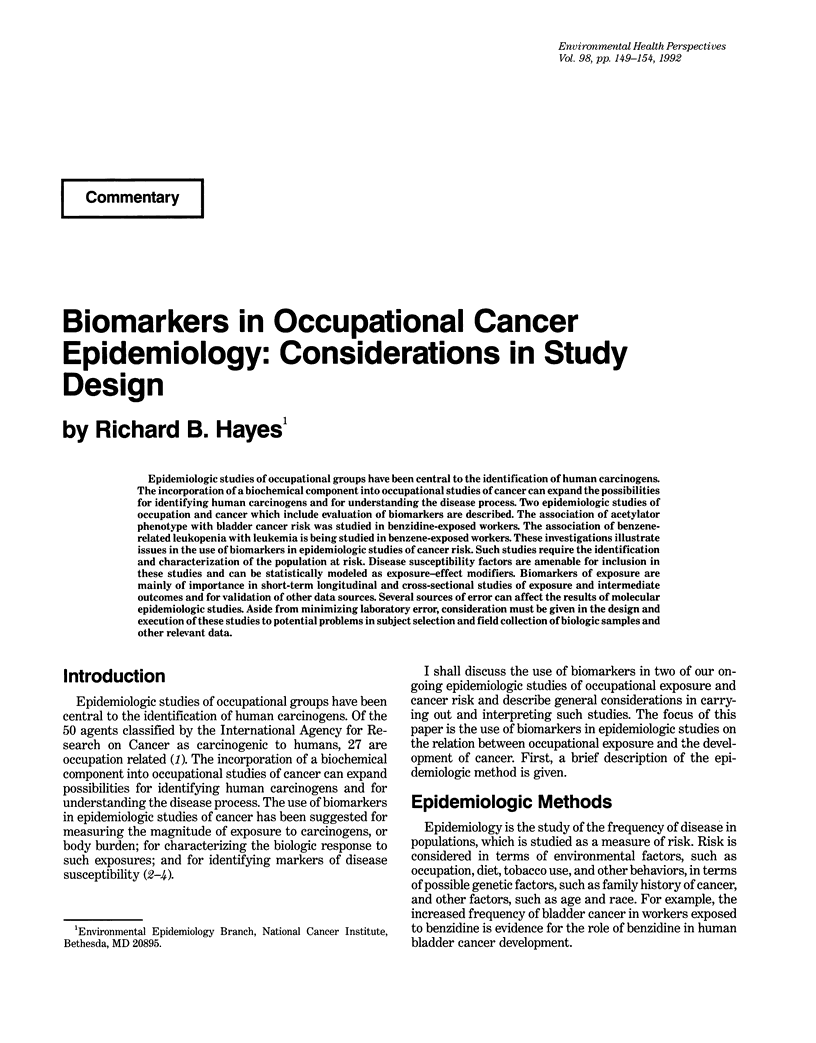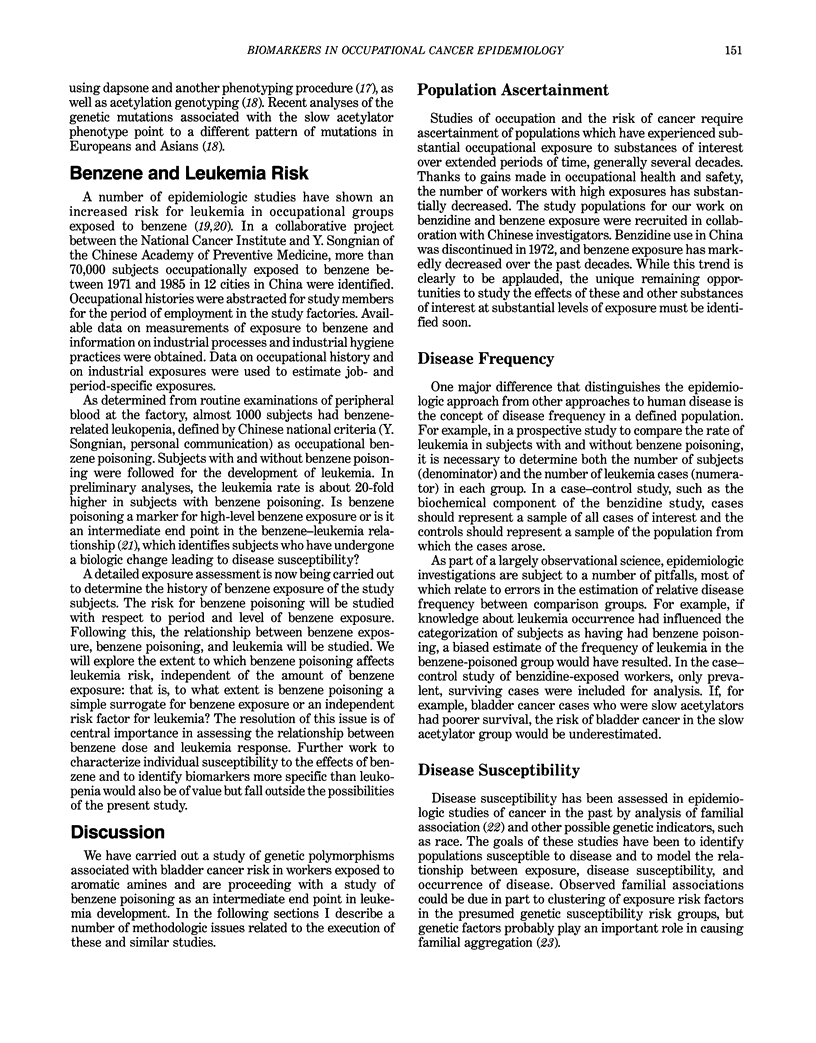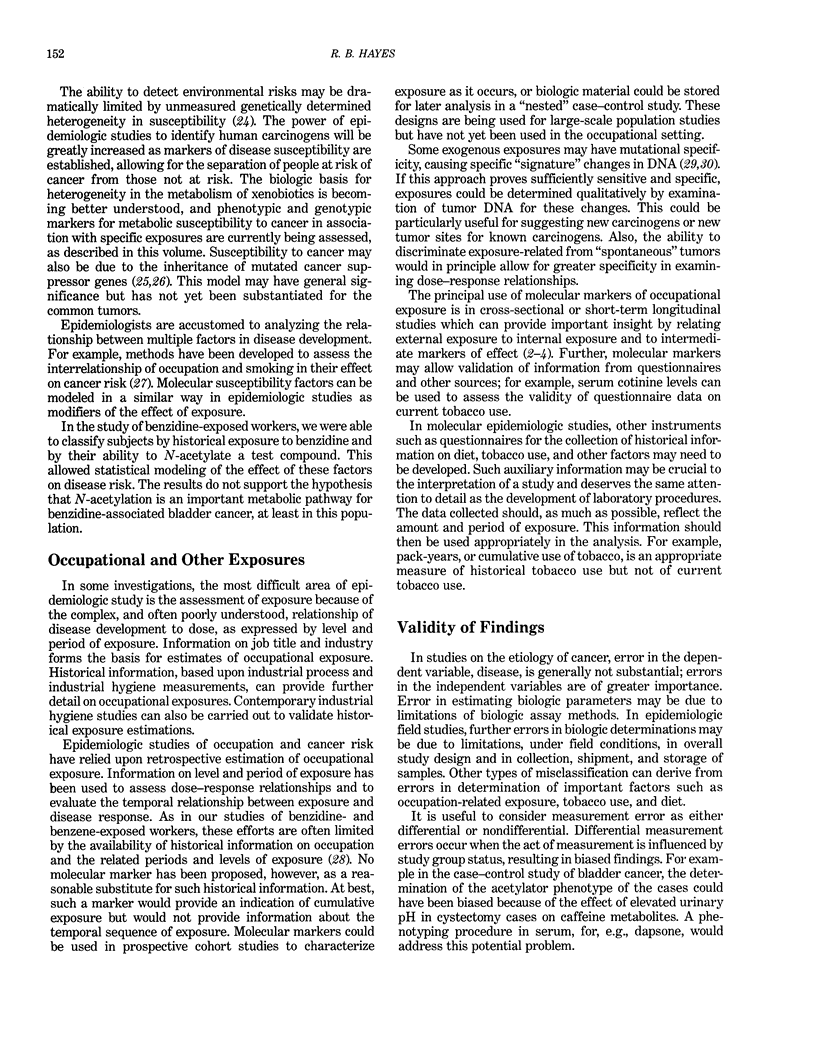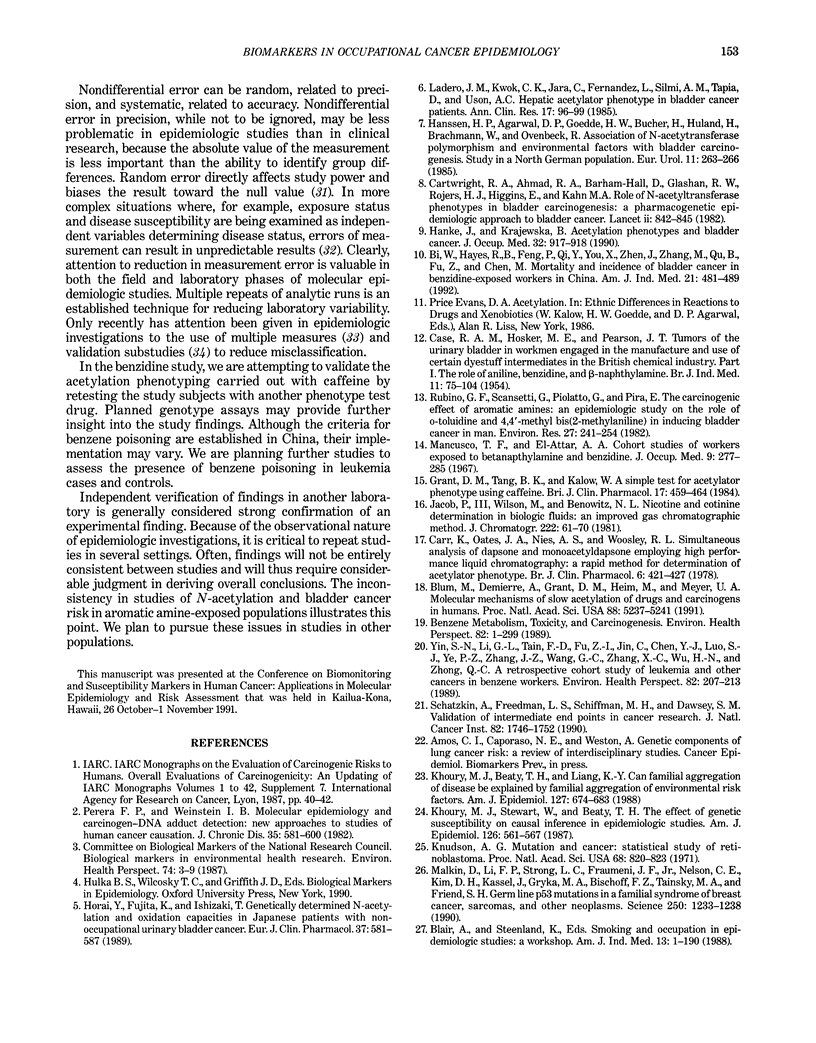Abstract
Epidemiologic studies of occupational groups have been central to the identification of human carcinogens. The incorporation of a biochemical component into occupational studies of cancer can expand the possibilities for identifying human carcinogens and for understanding the disease process. Two epidemiologic studies of occupation and cancer which include evaluation of biomarkers are described. The association of acetylator phenotype with bladder cancer risk was studied in benzidine-exposed workers. The association of benzene-related leukopenia with leukemia is being studied in benzene-exposed workers. These investigations illustrate issues in the use of biomarkers in epidemiologic studies of cancer risk. Such studies require the identification and characterization of the population at risk. Disease susceptibility factors are amenable for inclusion in these studies and can be statistically modeled as exposure-effect modifiers. Biomarkers of exposure are mainly of importance in short-term longitudinal and cross-sectional studies of exposure and intermediate outcomes and for validation of other data sources. Several sources of error can affect the results of molecular epidemiologic studies. Aside from minimizing laboratory error, consideration must be given in the design and execution of these studies to potential problems in subject selection and field collection of biologic samples and other relevant data.
Full text
PDF





Selected References
These references are in PubMed. This may not be the complete list of references from this article.
- Bi W., Hayes R. B., Feng P., Qi Y., You X., Zhen J., Zhang M., Qu B., Fu Z., Chen M. Mortality and incidence of bladder cancer in benzidine-exposed workers in China. Am J Ind Med. 1992;21(4):481–489. doi: 10.1002/ajim.4700210404. [DOI] [PubMed] [Google Scholar]
- Blum M., Demierre A., Grant D. M., Heim M., Meyer U. A. Molecular mechanism of slow acetylation of drugs and carcinogens in humans. Proc Natl Acad Sci U S A. 1991 Jun 15;88(12):5237–5241. doi: 10.1073/pnas.88.12.5237. [DOI] [PMC free article] [PubMed] [Google Scholar]
- CASE R. A., HOSKER M. E., McDONALD D. B., PEARSON J. T. Tumours of the urinary bladder in workmen engaged in the manufacture and use of certain dyestuff intermediates in the British chemical industry. I. The role of aniline, benzidine, alpha-naphthylamine, and beta-naphthylamine. Br J Ind Med. 1954 Apr;11(2):75–104. doi: 10.1136/oem.11.2.75. [DOI] [PMC free article] [PubMed] [Google Scholar]
- Carr K., Oates J. A., Nies A. S., Woosley R. L. Simultaneous analysis of dapsone and monoacetyldapsone employing high performance liquid chromatography: a rapid method for determination of acetylator phenotype. Br J Clin Pharmacol. 1978 Nov;6(5):421–427. doi: 10.1111/j.1365-2125.1978.tb04606.x. [DOI] [PMC free article] [PubMed] [Google Scholar]
- Cartwright R. A., Glashan R. W., Rogers H. J., Ahmad R. A., Barham-Hall D., Higgins E., Kahn M. A. Role of N-acetyltransferase phenotypes in bladder carcinogenesis: a pharmacogenetic epidemiological approach to bladder cancer. Lancet. 1982 Oct 16;2(8303):842–845. doi: 10.1016/s0140-6736(82)90810-8. [DOI] [PubMed] [Google Scholar]
- Grant D. M., Tang B. K., Kalow W. A simple test for acetylator phenotype using caffeine. Br J Clin Pharmacol. 1984 Apr;17(4):459–464. doi: 10.1111/j.1365-2125.1984.tb02372.x. [DOI] [PMC free article] [PubMed] [Google Scholar]
- Greenland S. The effect of misclassification in the presence of covariates. Am J Epidemiol. 1980 Oct;112(4):564–569. doi: 10.1093/oxfordjournals.aje.a113025. [DOI] [PubMed] [Google Scholar]
- Hanke J., Krajewska B. Acetylation phenotypes and bladder cancer. J Occup Med. 1990 Sep;32(9):917–918. doi: 10.1097/00043764-199009000-00032. [DOI] [PubMed] [Google Scholar]
- Hanssen H. P., Agarwal D. P., Goedde H. W., Bucher H., Huland H., Brachmann W., Ovenbeck R. Association of N-acetyltransferase polymorphism and environmental factors with bladder carcinogenesis. Study in a north German population. Eur Urol. 1985;11(4):263–266. doi: 10.1159/000472511. [DOI] [PubMed] [Google Scholar]
- Hollstein M., Sidransky D., Vogelstein B., Harris C. C. p53 mutations in human cancers. Science. 1991 Jul 5;253(5015):49–53. doi: 10.1126/science.1905840. [DOI] [PubMed] [Google Scholar]
- Horai Y., Fujita K., Ishizaki T. Genetically determined N-acetylation and oxidation capacities in Japanese patients with non-occupational urinary bladder cancer. Eur J Clin Pharmacol. 1989;37(6):581–587. doi: 10.1007/BF00562549. [DOI] [PubMed] [Google Scholar]
- Jacob P., 3rd, Wilson M., Benowitz N. L. Improved gas chromatographic method for the determination of nicotine and cotinine in biologic fluids. J Chromatogr. 1981 Jan 2;222(1):61–70. doi: 10.1016/s0378-4347(00)81033-6. [DOI] [PubMed] [Google Scholar]
- Khoury M. J., Beaty T. H., Liang K. Y. Can familial aggregation of disease be explained by familial aggregation of environmental risk factors? Am J Epidemiol. 1988 Mar;127(3):674–683. doi: 10.1093/oxfordjournals.aje.a114842. [DOI] [PubMed] [Google Scholar]
- Khoury M. J., Stewart W., Beaty T. H. The effect of genetic susceptibility on causal inference in epidemiologic studies. Am J Epidemiol. 1987 Oct;126(4):561–567. doi: 10.1093/oxfordjournals.aje.a114695. [DOI] [PubMed] [Google Scholar]
- Knudson A. G., Jr Mutation and cancer: statistical study of retinoblastoma. Proc Natl Acad Sci U S A. 1971 Apr;68(4):820–823. doi: 10.1073/pnas.68.4.820. [DOI] [PMC free article] [PubMed] [Google Scholar]
- Ladero J. M., Kwok C. K., Jara C., Fernandez L., Silmi A. M., Tapia D., Uson A. C. Hepatic acetylator phenotype in bladder cancer patients. Ann Clin Res. 1985;17(3):96–99. [PubMed] [Google Scholar]
- Malkin D., Li F. P., Strong L. C., Fraumeni J. F., Jr, Nelson C. E., Kim D. H., Kassel J., Gryka M. A., Bischoff F. Z., Tainsky M. A. Germ line p53 mutations in a familial syndrome of breast cancer, sarcomas, and other neoplasms. Science. 1990 Nov 30;250(4985):1233–1238. doi: 10.1126/science.1978757. [DOI] [PubMed] [Google Scholar]
- Mancuso T. F., el-Attar A. A. Cohort study of workers exposed to betanaphthylamine and benzidine. J Occup Med. 1967 Jun;9(6):277–285. [PubMed] [Google Scholar]
- Marshall J. R. The use of dual or multiple reports in epidemiologic studies. Stat Med. 1989 Sep;8(9):1041–1073. doi: 10.1002/sim.4780080904. [DOI] [PubMed] [Google Scholar]
- Perera F. P., Weinstein I. B. Molecular epidemiology and carcinogen-DNA adduct detection: new approaches to studies of human cancer causation. J Chronic Dis. 1982;35(7):581–600. doi: 10.1016/0021-9681(82)90078-9. [DOI] [PubMed] [Google Scholar]
- Rosner B., Willett W. C., Spiegelman D. Correction of logistic regression relative risk estimates and confidence intervals for systematic within-person measurement error. Stat Med. 1989 Sep;8(9):1051–1073. doi: 10.1002/sim.4780080905. [DOI] [PubMed] [Google Scholar]
- Rubino G. F., Scansetti G., Piolatto G., Pira E. The carcinogenic effect of aromatic amines: an epidemiological study on the role of o-toluidine and 4,4'-methylene bis (2-methylaniline) in inducing bladder cancer in man. Environ Res. 1982 Apr;27(2):241–254. doi: 10.1016/0013-9351(82)90079-2. [DOI] [PubMed] [Google Scholar]
- Schatzkin A., Freedman L. S., Schiffman M. H., Dawsey S. M. Validation of intermediate end points in cancer research. J Natl Cancer Inst. 1990 Nov 21;82(22):1746–1752. doi: 10.1093/jnci/82.22.1746. [DOI] [PubMed] [Google Scholar]
- Thilly W. G., Liu V. F., Brown B. J., Cariello N. F., Kat A. G., Keohavong P. Direct measurement of mutational spectra in humans. Genome. 1989;31(2):590–593. doi: 10.1139/g89-109. [DOI] [PubMed] [Google Scholar]
- Walker A. M., Blettner M. Comparing imperfect measures of exposure. Am J Epidemiol. 1985 Jun;121(6):783–790. doi: 10.1093/oxfordjournals.aje.a114049. [DOI] [PubMed] [Google Scholar]
- Yin S. N., Li G. L., Tain F. D., Fu Z. I., Jin C., Chen Y. J., Luo S. J., Ye P. Z., Zhang J. Z., Wang G. C. A retrospective cohort study of leukemia and other cancers in benzene workers. Environ Health Perspect. 1989 Jul;82:207–213. doi: 10.1289/ehp.8982207. [DOI] [PMC free article] [PubMed] [Google Scholar]


